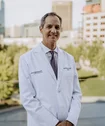Say hello to AI-powered preventive heart care
If not for AI analysis of a CT scan showing his heart and coronary arteries, patient James Doe—not his real name—may have died of a “widowmaker” heart attack before experiencing a single symptom.
Cardiologist David Hinchman, MD, remembers the case well.
The AI suggested Mr. Doe needed immediate attention, Hinchman tells Radiology Business. Specifically, the algorithm identified a 90% soft-plaque blockage in the proximal third of his left anterior descending artery (LAD).
When the analysis came in, Mr. Doe was working at a construction site 100 or so miles away from Hinchman’s practice, High Desert Heart & Vascular in Meridian, Idaho.
“The software indicated the blockage consisted of low-attenuation plaque with high-risk features,” recalls Hinchman, a co-founder of the practice. “This told us the plaque was unstable and vulnerable to rupture.”
Interestingly, Mr. Doe had a coronary artery calcium score of 0, which is why he’d gone about his business without much concern. A blood test had shown a high lipid count, but he had no symptoms.
“We’d ordered a coronary computed tomography angiography (CCTA) scan because both physician and patient wanted to know the risk of heart disease,” says Hinchman. “When we discovered this lesion with all this soft plaque in a critical proximal LAD territory, we realized he was in imminent danger. We started calling him urgently.”
The practice encouraged Mr. Doe to come in ASAP. When he got to the hospital, Hinchman’s colleague took him to the cardiac catheterization lab, performed an angiogram and stented the vessel without delay.
The outcome: “He never suffered any damage to his heart,” Hinchman happily recalls.
Atherosclerosis: Busted
The AI used at High Desert was developed and is marketed by Denver-based Cleerly. Hinchman notes that Cleerly’s founder and CEO, James Min, MD, often emphasizes the product’s benefits for asymptomatic but atherosclerotic patients like patient James Doe.
“They’re the ones who need to know they’re at risk well ahead of time, so they can head off major trouble,” explains Hinchman, who’s been practicing since the mid-’90s and sub-specializing in invasive, noninterventional angiography. “Unfortunately, so far the societies have only given indications for CCTA in symptomatic people, which is really somewhat backwards.”

"I think AI is going to change the way we detect and treat coronary disease, because it lets us see disease brewing decades ahead of an episode."
David Hinchman, MD, Co-founder, High Desert Heart & Vascular
Cleerly’s AI works with CCTA to help identify and classify atherosclerosis in patients whose blockages evade the human gaze. The product supports precise early diagnoses that, as with many serious health conditions, can mean the literal difference between long life and untimely death.
“I think AI is going to change the way we detect and treat coronary disease, because it lets us see disease brewing decades ahead of an episode,” he says. “That’s key, because the episode may arrive when the patient has late-stage disease and all we can do is rescue or salvage.”
‘Gatekeeper’ of the cath lab
Hinchman has many more plaudits for Cleerly, such as:
- “I’m at the sunsetting portion of my career now. Looking back to my early years in medicine, I wanted to do preventative care. I never really got the chance—until now.”
- “As Cleerly CMO James Earls, MD, has demonstrated, serial testing of small lesions shows they often grow, over time, to dangerous proportions. The long-term risks of those small lesions—if left undiscovered by AI on CCTA—are real.”
- “You also can decide to run a functional test on the CCTA image data using a module called Cleerly Ischemia. This uses machine learning to predict whether the lesion is impairing blood flow to the point where we might want to do revascularization with a bypass or a stent. That’s a decision I make based on whether or not there’s a 40% to 90% lesion blockage.”
- “The software has reduced the number of people we take to the cath lab. And it’s increased the severity of disease in the patients we treat in that setting. So if we schedule you for an invasive angiogram these days, there’s a pretty high likelihood we know you have disease that’s serious enough to need a stent or a referral to bypass surgery.”
Adding to the latter point, Hinchman adds that the care team at High Desert Heart & Vascular—four cardiologists and four nurse practitioners—are serving patients better than ever before.
“These days we’ll get a noninvasive CCTA analysis with Cleerly and know for sure whether the patient truly needs an invasive angiogram,” he says. “Is Cleerly a gatekeeper for the cath lab? Not exactly—but, to some extent, it does function that way.”
Learn more about Cleerly here and more about High Desert Heart & Vascular here.

